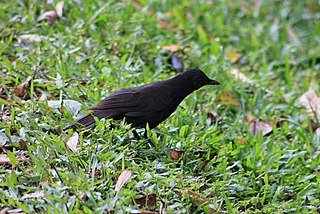
The earless monitor lizard is a semiaquatic, brown lizard native to the Southeast Asian island of Borneo. It is the only living species in the family Lanthanotidae and it is related to the true monitor lizards.
The Anguillidae are a family of ray-finned fish that contains the freshwater eels. Eighteen of the 19 extant species and six subspecies in this family are in the genus Anguilla. They are elongated fish with snake-like bodies, their long dorsal, caudal and anal fins forming a continuous fringe. They are catadromous fish, spending their adult lives in fresh water, but migrating to the ocean to spawn. Eels are an important food fish and some species are now farm-raised, but not bred in captivity. Many populations in the wild are now threatened, and Seafood Watch recommend consumers avoid eating anguillid eels.
Cyathea borneensis is a species of tree fern native to southern parts of Thailand and Cambodia, as well as the Malay Peninsula and Borneo, where it grows in lowland forest at an altitude of 400–1100 m. The trunk is erect and usually up to 2 m tall or more. Fronds are bi- to tripinnate and 2–3 m long. The stipe is spiny and warty. It is covered with scattered scales that are dark, glossy and have narrow, fragile edges. Sori are close to fertile pinnule midveins and covered by thin indusia.

The Borneo shark is a species of requiem shark, and part of the family Carcharhinidae. Extremely rare, it is known only from inshore waters around Mukah in northwestern Borneo, though it may once have been more widely distributed. A small, gray shark reaching 65 cm (26 in) in length, this species is the only member of its genus with a row of enlarged pores above the corners of its mouth. It has a slender body with a long, pointed snout and a low second dorsal fin placed posterior to the anal fin origin.
Gastrophrynoides borneensis is a species of frog in the family Microhylidae. It is endemic to Borneo and is known from Sarawak and Sabah in Malaysia, but it is likely to be also found in adjacent Kalimantan (Indonesia). Common name Borneo narrowmouth toad has been coined for it.
Microhyla borneensis, also known as the Matang narrow-mouthed frog, is a species of microhylid frog found in the Matang Range in Sarawak, Borneo. It was once the smallest known frog from the Old World. Adult males of this species have a snout-vent length (SVL) of 10.6–12.8 mm (0.42–0.50 in),but adult males can reach a maximum of 13 mm (0.51 in),and adult females of this species have a snout-vent length of 16–19 mm (0.63–0.75 in), Tadpoles measure just 3 mm.

The white-crowned forktail is a species of forktail in the family Muscicapidae. Scientifically described in 1818, it has six subspecies, each occupying a different geographic range. The largest of the forktails, Enicurus leschenaulti, is between 25 and 28 centimetres long. It has a black throat and breast, black mantle, and largely black wings. The rump and lower back are white, and the bird has a prominent white crown, from which it gets its name. As with other forktails, the tail is long, deeply forked, and banded in black and white. A variety of whistling and clicking calls have been described. Slight morphological differences have been observed between subspecies.

The Bornean whistling thrush is a species of bird in the family Muscicapidae. It is found in Indonesia and Malaysia, where it is endemic to the island of Borneo. Its natural habitat is subtropical or tropical moist montane forests.

The Bornean horseshoe bat is a species of bat in the family Rhinolophidae. It is found in Brunei, Cambodia, Indonesia, Laos, Malaysia, and Vietnam.
Horsfieldia borneensis is a species of plant in the family Myristicaceae. It is a tree endemic to Borneo.
Zollingeria borneensis is a species of plant in the family Sapindaceae. It is endemic to Borneo, and is threatened by habitat loss.

Trimeresurus borneensis, commonly known as the Bornean pit viper, is a venomous pit viper species endemic to the island of Borneo. No subspecies are currently recognized.

Agathis borneensis, also known as Borneo kauri, is a species of conifer in the Araucariaceae family. It occurs in lowland to upland tropical rainforest up to elevations of 2,400 metres (8,000 ft).
Diospyros borneensis is a tree in the Ebenaceae family. It grows up to 20 metres (70 ft) tall. Twigs are reddish brown when young, drying black. Inflorescences bear up to 20 flowers. The fruits are round, drying black, up to 4.2 cm (2 in) in diameter. The tree is named for Borneo. Habitat is forests from sea-level to 1,000 metres (3,300 ft) altitude. D. borneensis is found in Peninsular Thailand, Sumatra, Peninsular Malaysia and Borneo.
Canarium pilosum subsp. borneensis is a subspecies of Canarium pilosum. It is a tree in the family Burseraceae. The subspecies is named for Borneo.

Scorodocarpus is a monotypic genus of plant in the family Olacaceae. It has also been classified in the family Strombosiaceae. The generic name is from the Greek meaning "garlic fruit", referring to the smell of the fruit. As of June 2014 The Plant List recognises the single species Scorodocarpus borneensis. The specific epithet borneensis is from the Latin meaning "of Borneo".
Acalolepta borneensis is a species of beetle in the family Cerambycidae. It was described by Stephan von Breuning in 1935. It is known from Borneo.
Cenodocus borneensis is a species of beetle in the family Cerambycidae. It was described by Gilmour and Stephan von Breuning in 1963. It is known from Borneo.
Mispilodes borneensis is a species of beetle in the family Cerambycidae. It was described by Stephan von Breuning in 1938. It is known from Borneo.

Osteochilus borneensis is a species of cyprinid fish endemic to Borneo and Sumatra.









